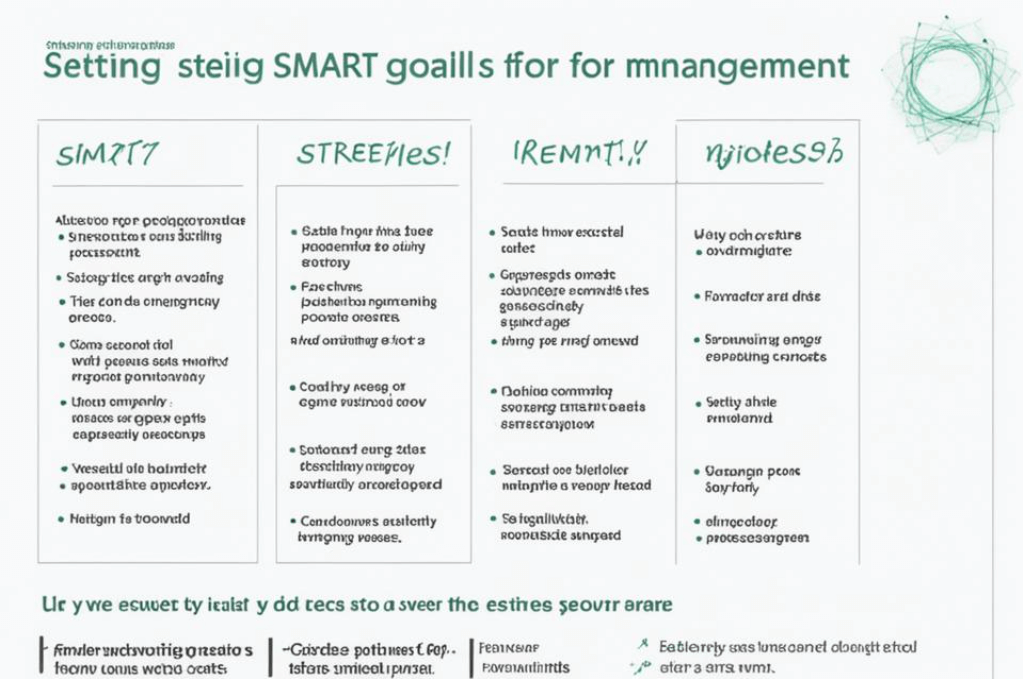Stress can have a big impact on our mental health, causing feelings of overwhelm and anxiety. That’s why it’s important to find effective ways to manage stress and achieve peace of mind. One helpful approach is to set SMART goals, which are specific, measurable, achievable, relevant, and time-bound. By setting SMART goals for stress management, we can create a clear plan of action and track our progress along the way. In this article, we will explore the benefits of setting SMART goals for stress management and provide practical strategies and examples to help you achieve peace of mind.
Contents
I. Understanding SMART goals
II. Specific strategies for setting SMART goals for stress management
III. Examples of SMART goals for stress management
IV. Tips for successfully achieving SMART goals for stress management
V. Conclusion
I. Understanding SMART goals

Setting SMART goals means creating specific, measurable, achievable, relevant, and time-bound goals. Let’s break down what each of these means:
1. Specific: Your goal should be clear and well-defined. Instead of saying “I want to reduce stress,” be specific about what aspect of stress you want to address, such as work-related stress or relationship stress.
2. Measurable: It’s important to have a way to track your progress. For example, instead of saying “I want to exercise more,” set a goal of exercising for 30 minutes, three times a week. This way, you can measure if you’re meeting your goal or not.
3. Achievable: Make sure your goals are realistic and attainable. Setting goals that are too challenging or impossible to achieve can lead to frustration and discouragement. Start with smaller, achievable steps and gradually increase the difficulty as you progress.
4. Relevant: Your goals should be meaningful and relevant to you. Consider your values, priorities, and what will truly make a difference in reducing your stress levels. Align your goals with what matters most to you.
5. Time-bound: Set a deadline for your goals to create a sense of urgency. For example, instead of saying “I want to start practicing mindfulness meditation,” set a goal of practicing mindfulness meditation for 10 minutes every day for the next month.
Understanding these SMART goal principles will help you create effective strategies for managing stress and achieving peace of mind.
II. Specific strategies for setting SMART goals for stress management

A. Identify specific stressors and triggers: Take the time to understand what exactly is causing stress in your life. Is it work-related, relationship issues, or financial worries? By pinpointing the specific stressors, you can create goals that directly address those areas.
B. Set measurable goals to track progress: Make sure your goals are measurable so that you can track your progress. For example, instead of saying “I want to reduce stress,” set a goal like “I will practice deep breathing exercises for 10 minutes every day.” This way, you can see how consistently you are meeting your goal.
C. Ensure goals are achievable and realistic: It’s important to set goals that are within your reach. If you set unrealistic goals, you may become discouraged and give up. Start with small, achievable steps and gradually increase the difficulty as you progress.
D. Make goals relevant to personal values and priorities: Align your goals with your personal values and priorities. Ask yourself what is truly important to you and how reducing stress will contribute to those values and priorities. This will give you a sense of purpose and motivation.
E. Set time-bound goals to create a sense of urgency: Give yourself a deadline for achieving your goals. This will create a sense of urgency and help you stay focused. For example, set a goal to practice stress-reducing activities for 30 minutes every day for the next two weeks.
By following these specific strategies for setting SMART goals, you can effectively manage stress and work towards achieving peace of mind.
III. Examples of SMART goals for stress management

Goal 1: Spend 10 minutes practicing mindfulness meditation every day for the next month to reduce stress levels.
Goal 2: Exercise for at least 30 minutes, three times a week, to help manage and reduce stress.
Goal 3: Make self-care a priority by scheduling one hour of “me time” every weekend for relaxation and rejuvenation.
IV. Tips for successfully achieving SMART goals for stress management

A. Break down goals into smaller, manageable tasks: Instead of overwhelming yourself with a big goal, break it down into smaller steps that are easier to tackle. This will make it feel more achievable and less stressful.
B. Seek support from friends, family, or a therapist: Don’t be afraid to ask for help and support from those around you. They can offer guidance, encouragement, and accountability to help you stay on track with your goals.
C. Celebrate milestones and reward yourself for progress made: Acknowledge and celebrate the small victories along the way. Treat yourself to something you enjoy as a reward for reaching milestones. This will motivate you to keep going and maintain a positive mindset.
D. Adapt goals as needed to accommodate changing circumstances: Life can be unpredictable, and circumstances may change. Be flexible and willing to adjust your goals if necessary. It’s important to be realistic and adapt your goals to fit your current situation.
By following these tips, you can increase your chances of successfully achieving your SMART goals for stress management. Remember, it’s a journey, and progress is more important than perfection. Stay committed and keep moving forward towards achieving peace of mind.
V. Conclusion
In conclusion, setting SMART goals for stress management is a helpful strategy to achieve peace of mind. By making goals that are specific, measurable, achievable, relevant, and time-bound, we can effectively manage our stress levels. It is important to identify our stressors and triggers, track our progress, and make goals that align with our values and priorities. Additionally, breaking down goals into smaller tasks, seeking support from others, and celebrating milestones can increase our chances of success. Remember, taking proactive steps towards managing stress can lead to a happier and healthier life.











